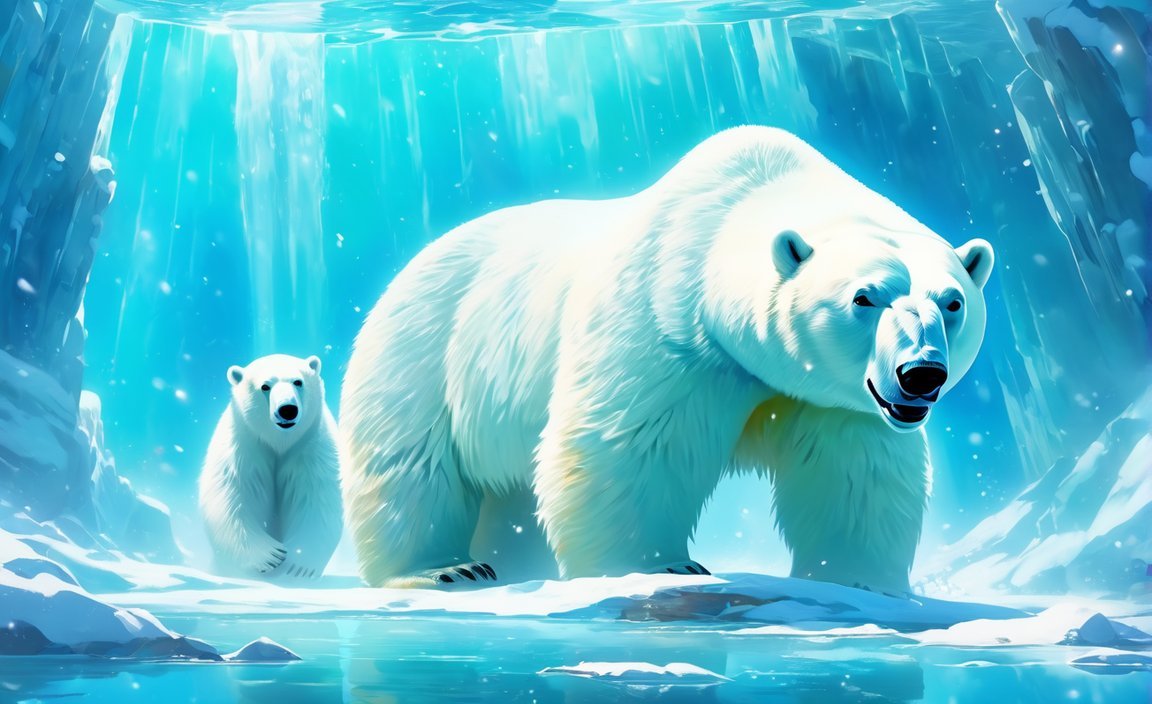The Incredible Strength of Polar Bears: Discover How Strong They Really Are

Curious about just how strong polar bears really are? Prepare to be amazed as we delve into the awe-inspiring world of these magnificent creatures. With their formidable physical abilities and astonishing resilience, polar bears have long captivated the imagination of wildlife enthusiasts and scientists alike. In this article, we will explore the incredible strength of polar bears, shedding light on their remarkable characteristics and unrivaled prowess in surviving the harsh and unforgiving Arctic environment. Get ready for a journey that will leave you in awe of the sheer power possessed by these majestic apex predators.
Key Takeaways:
- Polar bears are known for their immense strength, size, and speed, making them one of the most formidable predators in the animal kingdom.
- The average weight of an adult polar bear is up to 1300 pounds, making them ten times stronger than a human.
- Polar bears have a bite force of around 1200 pounds per square inch (PSI), making them one of the strongest biters in the animal kingdom.
- Their paw swipe force can reach an astonishing 59,500 lb-ft/s, allowing them to overpower their prey and defend themselves against potential threats.
- Polar bears have evolved and adapted to their harsh Arctic environment, resulting in their exceptional strength and physical capabilities.
- They are capable of lifting more than 1000 pounds of heavy icebergs, showcasing their strength and endurance.
- Polar bears are the largest bears in the world, with adult males growing up to 10 feet in length and reaching a height of about 5 feet at shoulder level.
- Climate change and habitat loss pose significant threats to polar bears’ survival, as the melting of Arctic sea ice affects their hunting and breeding habits.
- Conservation efforts are crucial to ensuring the long-term survival of these magnificent creatures in the face of changing Arctic environments.
How Strong is a Polar Bear
Polar bears, the powerhouses of the Arctic, are renowned for their immense strength and physical capabilities. But just how strong are these majestic creatures? Let’s delve into their incredible strength and discover what sets them apart from other bear species.
A Force to be Reckoned With
Polar bears are ten times stronger than humans, weighing up to 1300 pounds ^1^. Their extraordinary strength enables them to navigate their icy environment with ease, swimming for miles and breaking through thick ice. But it doesn’t stop there.
Bite Force and Paw Swipe Force
Polar bears possess a formidable bite force, measuring around 1200 pounds per square inch (PSI) ^3^. This makes them one of the strongest biters in the animal kingdom. Their immense paw swipe force is equally astonishing, reaching up to 59,500 lb-ft/s ^3^. These powerful swipes, combined with their massive size, allow polar bears to overpower their prey and fend off potential threats.
Evolution and Adaptation
The polar bear’s incredible strength is a result of their remarkable evolution and adaptation to the harsh Arctic environment ^3^. The need to hunt and kill marine mammals for survival has driven their physical development, making them highly efficient predators. They can even lift more than 1000 pounds of heavy icebergs, showcasing their exceptional strength and endurance ^1^.
Size Matters
Polar bears hold the title for being the largest bears in the world ^4^. Adult males can grow up to 10 feet in length and reach a height of about 5 feet at shoulder level when standing on all fours ^5^. Their powerful build, combined with well-developed muscles, contributes to their impressive strength and physical prowess.
Conservation Challenges
Despite their formidable strength, polar bears face numerous challenges, including climate change and habitat loss. The melting of Arctic sea ice, crucial for their hunting and breeding habits, poses a significant threat to their survival ^5^. Ongoing efforts are being made to protect and conserve these magnificent creatures to ensure their long-term existence in the changing Arctic environment.
Conclusion
Polar bears are undisputed powerhouses of the Arctic, with their immense strength, size, and speed setting them apart from other bear species. Their exceptional physical abilities, from their bite force to their paw swipe force, enable them to thrive in their harsh environment ^1^. However, safeguarding their future in the face of climate change and habitat loss remains crucial. So, let us continue to admire and protect these incredible creatures for generations to come.
Sources:
Are ducks mammals? Find out if these adorable animals belong to the mammal family here.
Curious about whether ducks can eat mushrooms? Discover the surprising answer here.
Can ducks see in the dark? Click here to uncover their unique nocturnal abilities.
Do lions like water? Dive into the world of these majestic creatures’ relationship with water here.
Comparison of Polar Bear Strength to Other Animals
Polar bears are undoubtedly the epitome of strength and power. As the largest and most powerful carnivore on land, they outshine other bear species in terms of size, strength, and speed. Let’s delve into the astonishing capabilities of these majestic creatures and compare their strength to other animals.
Size and Strength
When it comes to sheer size, polar bears reign supreme. An adult polar bear can weigh up to a whopping 1300 pounds, making them significantly larger than other bear species. But their size isn’t the only impressive aspect of their strength. They are ten times stronger than humans, showcasing their incredible power.
Biting Power
Now, let’s talk about their bite force. Imagine a bite that measures an astonishing 1,235 pounds per square inch (PSI). That’s stronger than the bite of a Bengal tiger and around eight times more powerful than that of a human! With such a formidable bite, polar bears can effortlessly overpower their prey.
Paw Swipe Force
But it doesn’t end there. Polar bears also possess an astonishing paw swipe force. Their power-packed paws can deliver a force of over 1,800 pounds, which is five times stronger than the punch force of a human. This breathtaking strength allows them to defend themselves and secure their dominance in the Arctic kingdom.
Comparison to Other Bears
If we put polar bears head-to-head with other bear species, they clearly come out on top in terms of strength.
Bite Force Comparison
Polar bears have a greater bite force of 1,235 PSI compared to grizzly bears, which measure around 975 PSI. This means that polar bears have a stronger bite, making them unmatched in the animal kingdom.
Paw Swipe Force Comparison
Similarly, when it comes to paw swipe force, polar bears also outshine grizzly bears. While grizzlies deliver a paw swipe force of up to 47,600 lb.-ft./s, polar bears can unleash a staggering force of up to 59,500 lb.-ft./s. Once again, polar bears display their extraordinary power in comparison to their bear counterparts.
Comparing with Black Bears
Even when comparing polar bears to black bears, which are not as strong as polar and grizzly bears, the difference in strength is still apparent. Black bears can deliver a powerful bite, measuring between 650 and 975 PSI. Though not quite on the same level as polar bears or grizzlies, their bite force is not to be underestimated.
Habitat and Predators
Polar bears are perfectly adapted to survive in the harsh and frozen conditions of the Arctic. With no natural predators, they stand as the apex predators in their habitat. Their immense strength and fearless nature make them extremely dangerous if encountered in the wild. In fact, polar bears exhibit no fear of humans, adding to their formidable reputation.
Sources:
Key Takeaways:
- Polar bears are the largest and most powerful carnivore on land.
- They are ten times stronger than humans and can weigh up to 1300 pounds.
- Polar bears possess a bite force of 1,235 PSI, surpassing that of a Bengal tiger and humans.
- Their paw swipe force is over 1,800 pounds, making them five times stronger in this regard compared to a human.
- In comparisons to other bear species, polar bears have a greater bite force and paw swipe force.
- Polar bears are apex predators and have no natural predators in their Arctic habitat, making them extremely dangerous if encountered in the wild.
Polar Bear Strength in Surviving Harsh Arctic Conditions
Key Takeaways:
– Polar bears possess incredible strength, allowing them to thrive in the harsh Arctic conditions.
– Their strong neck and shoulder muscles support their large heads and heavy fur coats.
– With immense paws, legs, necks, and shoulders, polar bears have the power to take down seals and defend themselves against other bears.
– They are approximately ten times stronger than humans, with adult polar bears weighing up to 1300 pounds.
– The polar bears’ strength enables them to lift heavy icebergs, weighing over 1000 pounds.
– These remarkable creatures rely on sea ice for essential activities like hunting, traveling, and breeding, making them highly adaptable to their Arctic environment.
Polar bears are known for their extraordinary strength, allowing them to thrive in the harsh Arctic conditions. Their powerful physique and adaptations enable them to navigate and survive in one of the most extreme environments on Earth.
Polar bears possess incredibly strong neck and shoulder muscles, which support their large heads and provide stability while swimming or standing. These muscles allow them to efficiently maneuver and lift heavy objects.
The immense paws, legs, necks, and shoulders of polar bears give them the power to take down seals, their primary prey, and hold their own against other bears. With an adult polar bear weighing up to 1300 pounds, these magnificent creatures are approximately ten times stronger than humans.
Their strength is further showcased by their ability to lift heavy icebergs weighing over 1000 pounds. This incredible feat exemplifies their exceptional power and endurance in the challenging Arctic environment.
Polar bears rely on sea ice for essential activities such as hunting, traveling, and breeding. Their strength and adaptations enable them to navigate across expansive ice surfaces, providing them access to their prey and potential mates.
As apex predators, polar bears play a crucial role in the Arctic marine ecosystem. They are significant indicators of the health of their habitat, as any disruption or decline in their population can signify problems within the ecosystem.
However, polar bears face significant challenges due to climate change. Shrinking sea ice negatively impacts their ability to hunt and eat, affecting their survival. Polar bears now face a shorter sea ice season, reducing their hunting and breeding opportunities.
Despite these challenges, scientists have observed certain subpopulations of polar bears, such as those in southeastern Greenland, adapt to survive with less sea ice. These bears have learned to hunt from ice that breaks off glaciers, showcasing their resilience and ability to adapt to changing conditions.
In conclusion, polar bears possess incredible strength and adaptations that allow them to overcome the harsh Arctic conditions. Their powerful physique, strong muscles, and adaptability to changing environments make them a remarkable species deserving of our admiration and protection.
Sources:
– Roaring Nature
– Zooologist
The Role of Polar Bear Strength in Their Conservation Status
Polar bears, the magnificent creatures of the Arctic, possess incredible strength that plays a critical role in their conservation status. As an apex predator, their strength is not only awe-inspiring but also vital for their survival in the face of ongoing threats. In this article, we will explore the remarkable power of polar bears and its significance in their conservation efforts.
The Incredible Physical Strength of Polar Bears
Polar bears are renowned for their exceptional size and strength. Weighing up to 1300 pounds, they are ten times stronger than humans. These majestic giants can lift heavy objects weighing over 1000 pounds, showcasing their remarkable physical prowess. With a bite force measuring around 1200 pounds per square inch, polar bears rank among the strongest biters in the animal kingdom. Their paw swipe force can reach up to 59,500 lb-ft/s, enabling them to overpower their prey and defend themselves effectively.
Adaptation to a Harsh Environment
The strength of polar bears is not solely attributed to their evolutionary heritage but also a product of their adaptation to the unforgiving Arctic environment. The need to hunt and kill marine mammals for survival has driven their physical evolution. Immense paws, legs, necks, and shoulders equip them with the power to take down seals and withstand encounters with other bears. These adaptations have made polar bears the largest and most powerful carnivores on land.
Indicator of Arctic Ecosystem Health
Understanding the strength of polar bears is not only fascinating but also crucial in assessing the conservation status of the Arctic ecosystem. These majestic creatures act as sentinels, providing valuable insights into the overall health of the region. As top predators, they are highly sensitive to changes in their environment. The effects of climate change, particularly habitat loss due to melting sea ice, threaten their very existence. Rising temperatures cause the ice to melt earlier, forcing polar bears ashore before they have accumulated sufficient fat reserves to withstand the scarcity of food in late summer and early fall.
Conservation Efforts and the Future of Polar Bears
The conservation of polar bears is an urgent global priority. Organizations like the World Wildlife Fund (WWF) support sustainable hunting practices by Indigenous peoples, acknowledging the crucial role they play in polar bear conservation. However, the disappearing habitats of polar bears due to climate change and human activities present significant challenges. While polar bears are currently classified as threatened rather than endangered, their future remains uncertain without decisive actions to address climate change and protect their habitats.
Key Takeaways:
- Polar bears possess extraordinary strength, making them ten times stronger than humans and enabling them to lift heavy objects weighing over 1000 pounds.
- Their strength is a result of both evolution and adaptation to the harsh Arctic environment.
- Polar bears act as indicators of Arctic ecosystem health and the impacts of climate change.
- Conservation efforts are essential to protect polar bear habitats and ensure their long-term survival in a changing world.
Sources:
1. Wild Explained: How Strong Are Polar Bears? Polar Bear Strength Facts
2. Wikipedia: Polar bear conservation

FAQ
Q1: How strong are polar bears compared to humans?
A1: Polar bears are ten times stronger than humans in terms of sheer strength, with an adult polar bear weighing up to 1300 pounds.
Q2: What is the bite force of a polar bear?
A2: A polar bear has a bite force of 1,235 pounds per square inch (PSI), which is stronger than that of a Bengal tiger and around eight times more powerful than that of a human.
Q3: How powerful are the swipes of a polar bear’s paw?
A3: The swipe force of a polar bear’s paw can reach up to 59,500 lb-ft/s, which is five times stronger than the punch force of a human.
Q4: How much weight can a polar bear lift?
A4: Polar bears are so strong that they can lift more than 1000 pounds of heavy icebergs, showcasing their exceptional strength and endurance.
Q5: What challenges do polar bears face in terms of survival?
A5: Polar bears are facing challenges such as climate change and habitat loss. The melting of Arctic sea ice, which is essential for their hunting and breeding habits, poses a significant threat to their survival. Conservation efforts are crucial to safeguard their future in the changing Arctic environment.
- Mastering Leader in Spanish: The Complete Guide - April 19, 2025
- Uncovering Surprising Parallels: England Size Compared to US States - April 19, 2025
- Old Mexico Map: Border Shifts 1821-1857 - April 19, 2025
















